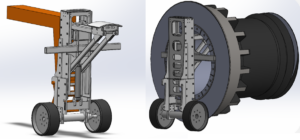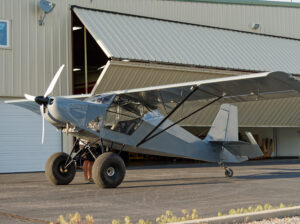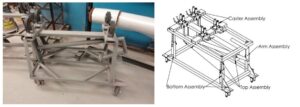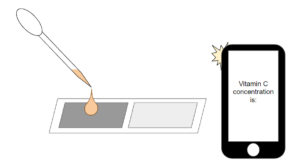Design Day Spring 2024
Design Day is an opportunity to share our Senior Design Showcase with the public. Seniors work in groups with faculty to design and test projects.
Senior Design Projects: Spring 2024
 Currently, visually impaired swimmers depend on helpers who use a padded stick to tap them, indicating when they’re nearing pool walls or lane lines. However, this method is rudimentary compared to the available technology. The objective of this project is to allow independent swimming among visually impaired individuals. To achieve this, a specialized device will be developed to aid swimmers in maintaining lane centering and to alert them of approaching walls. Our aim is to provide visually impaired swimmers with sensory feedback that simulates the sensation of vision, enhancing their swimming experience.
Currently, visually impaired swimmers depend on helpers who use a padded stick to tap them, indicating when they’re nearing pool walls or lane lines. However, this method is rudimentary compared to the available technology. The objective of this project is to allow independent swimming among visually impaired individuals. To achieve this, a specialized device will be developed to aid swimmers in maintaining lane centering and to alert them of approaching walls. Our aim is to provide visually impaired swimmers with sensory feedback that simulates the sensation of vision, enhancing their swimming experience.
Team: Ethan Thai (lead), Dylan Hinsley, Prem Sanyasi
Advisor: Mark Fehlberg

Mountain towns and high density areas spend tens of thousands of dollars each year moving snow from parking lots to off-site dump locations. Our objective is to develop a product that melts snow on-site, thus reducing the cost and liability of snow removal.
Team: Nate Jones (lead), Nathan Bartlett, Tim Goneau, Jon McMurray, Sebastian Serbinowski, Jim Thorpe
Advisor: Dr. Samira Shiri
 Rio Tinto uses semi-autonomous grinding (SAG) mills in its copper mining process to crush ore. These SAG mills are unique to the operation at the Rio Tinto Kennecott Site, meaning any proposed solution will be a completely novel one. On the far side from the feed inlet, the SAG mills are equipped with a funnel cone that’s used to recirculate crushed ore back into the mill for additional crushing if needed. These cones wear down with use and require replacement. The current replacement process relies on using a telehandler to move the cones into and out of the installation location. However, the telehandler is currently being used in an unsafe manner; the loads exceed manufacturer specifications on the equipment being used and the cone is not securely fastened during the transportation process. This project set out to determine how a new tool and/or installation method could improve the safety and efficiency of this maintenance task.
Rio Tinto uses semi-autonomous grinding (SAG) mills in its copper mining process to crush ore. These SAG mills are unique to the operation at the Rio Tinto Kennecott Site, meaning any proposed solution will be a completely novel one. On the far side from the feed inlet, the SAG mills are equipped with a funnel cone that’s used to recirculate crushed ore back into the mill for additional crushing if needed. These cones wear down with use and require replacement. The current replacement process relies on using a telehandler to move the cones into and out of the installation location. However, the telehandler is currently being used in an unsafe manner; the loads exceed manufacturer specifications on the equipment being used and the cone is not securely fastened during the transportation process. This project set out to determine how a new tool and/or installation method could improve the safety and efficiency of this maintenance task.
Team: Chris Thomsen (lead), Douglas Roberts, Shawn Haymore, Yeonsu Kim
Advisors: Dr Huebner, Andy Gill
 Northrop Grumman tests their rocket motors using a technique called a leak plug test. This test entails the usage of a “plug” that would allow the motor to be sealed. They then fill the motor with a mixture of nitrogen and helium gas. If the rocket doesn’t leak any of these gases within the timeframe of the test, the rocket motor passes the test. However, this process uses manual valves and requires the testing operator to control the test at a control area that is located away from the rocket. The objective of this project is to design a way for the testing operators to automatically run the test while being close to the rocket. This eliminates any human error while also increasing safety for the testing operators.
Northrop Grumman tests their rocket motors using a technique called a leak plug test. This test entails the usage of a “plug” that would allow the motor to be sealed. They then fill the motor with a mixture of nitrogen and helium gas. If the rocket doesn’t leak any of these gases within the timeframe of the test, the rocket motor passes the test. However, this process uses manual valves and requires the testing operator to control the test at a control area that is located away from the rocket. The objective of this project is to design a way for the testing operators to automatically run the test while being close to the rocket. This eliminates any human error while also increasing safety for the testing operators.
Team: Ricky Nishimura (lead), William Ascher, Finley Pinkas, Weston Oakeson, Sean Farrenkopf, Cameron Wright
Advisor: Andy Gill
 Our goal was to improve the aerodynamics of an experimental aircraft’s landing gear. To accomplish this, we designed, optimized, and manufactured fairings to cover the exposed gear.
Our goal was to improve the aerodynamics of an experimental aircraft’s landing gear. To accomplish this, we designed, optimized, and manufactured fairings to cover the exposed gear.
Team: Hudson Randle (team lead), Jeff Cunningham, Mohammed Alshahrani
Advisor: Randall Morrill
 Hill Air Force Base currently uses multiple of carts to hold parts during sandblasting. To cut down on the number of carts they must use, they are requesting that we design a single blast cart that can hold all the parts that need to be sandblasted. This cart must withstand sandblasting and chemical exposure, hold components of varying diameters and sizes, be adjusted to different heights, minimize sand buildup, and minimize sand binding of the wheels. This cart is important to Hill AFB in order to maintain the fleet of aircraft and aircraft landing gear.
Hill Air Force Base currently uses multiple of carts to hold parts during sandblasting. To cut down on the number of carts they must use, they are requesting that we design a single blast cart that can hold all the parts that need to be sandblasted. This cart must withstand sandblasting and chemical exposure, hold components of varying diameters and sizes, be adjusted to different heights, minimize sand buildup, and minimize sand binding of the wheels. This cart is important to Hill AFB in order to maintain the fleet of aircraft and aircraft landing gear.
Team: Zachary Mecham (lead), Charles Balle, John Brand, Mathis Bosteels, Milo Birdwell, Van Erickson
Advisor: Prof. Andy Gill
 As electronics and their power and cooling needs become more intensive, creative solutions to electronics cooling are more important than ever. The participating team competes in the ASME/IEEE Heat Sink Challenge to design, model, simulate, and submit a stainless steel heat sink that takes advantage of additive manufacturing capabilities in a vertical enclosure under forced air conditions. This year, guidelines such as low power and lower material conductivity bring a unique twist to the competition. Competing teams are judged on the thermal performance and creative use of additive manufacturing in each design, and if selected, are selected by GE Additive to print the heat sink and present their designs to the 2024 ITherm Conference.
As electronics and their power and cooling needs become more intensive, creative solutions to electronics cooling are more important than ever. The participating team competes in the ASME/IEEE Heat Sink Challenge to design, model, simulate, and submit a stainless steel heat sink that takes advantage of additive manufacturing capabilities in a vertical enclosure under forced air conditions. This year, guidelines such as low power and lower material conductivity bring a unique twist to the competition. Competing teams are judged on the thermal performance and creative use of additive manufacturing in each design, and if selected, are selected by GE Additive to print the heat sink and present their designs to the 2024 ITherm Conference.
Team: Zane Frey (lead), Eric Montenegro, Nathan Brown, Joshua Brodbeck, Oliver Proctor
Advisor: Dr. Sameer Rao

The measurement of the concentration of ascorbic acid in a given solution often demands cumbersome and costly methods such as utilizing redox titration with Indophenol where the addition of the acid turns the blue indophenol clear, or through photometric determination where the concentration is compared to the intensity of light after passing through a sample.
Due to the nature of current ascorbic acid concentration measurements, the Low-Cost Ascorbic Acid Senor Using Photographic Paper aims to redefine the process, striving for simplicity, affordability, and effectiveness by leveraging the cost efficacy of photographic paper. The goal of this project is to design a cost efficient and easily replicable, light-tight housing that allows for the distribution of an acid sample across photographic paper. Coupled with this will be software that images the processed ascorbic acid sample and converts said sample to a grayscale value that produces the corresponding ascorbic acid concentration value.
Team: John Stilley (lead), Mackenzie Ros, Nathan Smith, Jose A. Salinas-Barrera
Advisor: Dr. Roseanne Warren
 L3Harris is interested in utilizing magnetohydrodynamic (MHD) pumping in liquid heat exchangers due to the increased reliability that such systems provide. The objective of this project is to assess the feasibility of MHD pumping. In depth research utilizing FEM models and physical experiments will aid in the completion of this objective. This will allow L3Harris to determine if MHD heat exchangers should be pursued.
L3Harris is interested in utilizing magnetohydrodynamic (MHD) pumping in liquid heat exchangers due to the increased reliability that such systems provide. The objective of this project is to assess the feasibility of MHD pumping. In depth research utilizing FEM models and physical experiments will aid in the completion of this objective. This will allow L3Harris to determine if MHD heat exchangers should be pursued.
Team: Jacob Layton (lead), Vincent Funtanilla, Basil Zainaddin, Matthew Catmull, James Henry, Josh Broome
Advisor: Dr Pan
 We aimed to prove that a double-screw mechanical inerter is capable of reducing the effects of vibrations through the comparison of theoretical and experimental data.
We aimed to prove that a double-screw mechanical inerter is capable of reducing the effects of vibrations through the comparison of theoretical and experimental data.
Team: Kerrigan Denham (lead), Erik Kull, James Gaines, Syd Hurst, Hannah Harvey, Herold Silaire
Advisors: Dr. Pai Wang, Fei Chen
 Our project is to design, manufacture, and race a fluid powered bike for a competition sponsored by the National Fluid Power Association (NFPA) using hydraulic and pneumatic components. This project focuses on creative and new ways to utilize hydraulics and human power together. This vehicle challenge hopes to create an environment that results in the uncommon connections and breakthroughs in the fluid power industry, as well as introduce undergraduate students to the fluid power industry. The project culminates in four races that will push the bike to its limits in speed, endurance, and regeneration.
Our project is to design, manufacture, and race a fluid powered bike for a competition sponsored by the National Fluid Power Association (NFPA) using hydraulic and pneumatic components. This project focuses on creative and new ways to utilize hydraulics and human power together. This vehicle challenge hopes to create an environment that results in the uncommon connections and breakthroughs in the fluid power industry, as well as introduce undergraduate students to the fluid power industry. The project culminates in four races that will push the bike to its limits in speed, endurance, and regeneration.
Team: Alex England (lead), Alex Rayburn, Chris Weinand, Josh Stout, Isaac Lee, Trevor Jenkins
Advisor: Dr. M Dillon
 Our project aims to design and implement a system capable of analyzing residual gas and monitor internal pressure in a vacuum system without compromising the vacuum state. The data collected will be processed and measured to determine the cause and quantity of residual gases, prolonging the system’s lifespan.
Our project aims to design and implement a system capable of analyzing residual gas and monitor internal pressure in a vacuum system without compromising the vacuum state. The data collected will be processed and measured to determine the cause and quantity of residual gases, prolonging the system’s lifespan.
Team: Josue Flores-Gonzalez (lead), Hyunho Chae, Saif Mubarak
Advisors: Ronnie Boutte (Company), Andy Gill (U of U)
 Develop, manufacture, and launch a rocket for the Spaceport America Cup using a Commercial Off The Shelf [COTS] motor to achieve an apogee of 10,000ft. This project is in partnership with the University of Utah Aerospace Club and is building on the knowledge from the clubs participation last year. The rocket will deliver a payload of 8.8lbs in a CubeSat format which is comprised of a 360 GoPro camera attached within a clear section of the rocket.
Develop, manufacture, and launch a rocket for the Spaceport America Cup using a Commercial Off The Shelf [COTS] motor to achieve an apogee of 10,000ft. This project is in partnership with the University of Utah Aerospace Club and is building on the knowledge from the clubs participation last year. The rocket will deliver a payload of 8.8lbs in a CubeSat format which is comprised of a 360 GoPro camera attached within a clear section of the rocket.
Team: Joseph Phillips (lead), Kevin Bustamante, Austin Erickson, Sean Kimbrough, Cameron Vail, Caitlin Matthews
Advisors: Dr. Hochhalter, Bill Hooper
 To swim safely, visually impaired swimmers require additional support from other people outside the pool to prevent them from colliding with the walls and lane lines of the pool. Currently, support is offered by using a padded stick to tap the swimmer to inform them that they are approaching a wall. There currently is no method to prevent the swimmer from colliding with the lane lines. To enable visually impaired swimmers to swim independently, a device will be designed to help the swimmer stay centered in the swim lane (preventing the swimmer from colliding with the lane lines) and notify them of approaching walls (preventing the swimmer from colliding with the wall).
To swim safely, visually impaired swimmers require additional support from other people outside the pool to prevent them from colliding with the walls and lane lines of the pool. Currently, support is offered by using a padded stick to tap the swimmer to inform them that they are approaching a wall. There currently is no method to prevent the swimmer from colliding with the lane lines. To enable visually impaired swimmers to swim independently, a device will be designed to help the swimmer stay centered in the swim lane (preventing the swimmer from colliding with the lane lines) and notify them of approaching walls (preventing the swimmer from colliding with the wall).
Team: Jakon Allred (lead), Spencer Rolfson, Ammon Ferguson
Advisors: Dr. Mark Fehlberg, Mr. Mark Shveyd
 The University of Utah’s Environmental Fluid Dynamics Laboratory (EFD) analyzes the atmosphere’s boundary layers using tethered meteorological devices, also known as tethersondes. The laboratory currently uses outdated tethersondes and requires a reliable, accurate, and precise sensor array on board a tethersonde. Our team was tasked, by the EFD lab, with adding to a previous prototype where it would be able to wirelessly communicate with a ground crew, accurately measure wind velocity, and be able to map its orientation so that wind direction could be collected. This would be in addition to having temperature, pressure, humidity, and altitude being collected on board.
The University of Utah’s Environmental Fluid Dynamics Laboratory (EFD) analyzes the atmosphere’s boundary layers using tethered meteorological devices, also known as tethersondes. The laboratory currently uses outdated tethersondes and requires a reliable, accurate, and precise sensor array on board a tethersonde. Our team was tasked, by the EFD lab, with adding to a previous prototype where it would be able to wirelessly communicate with a ground crew, accurately measure wind velocity, and be able to map its orientation so that wind direction could be collected. This would be in addition to having temperature, pressure, humidity, and altitude being collected on board.
Team: Carson Beagles (lead), Quinn Brush, Tristan Archuleta, Jonjon Drain, Matthew Garceau
Advisors: Dr. Paradyjak, Matt Huckins
 The goal of this project is to provide modifications for an ELYLY snow scooter to facilitate use by individuals with complex disabilities. The ideal prototype allows for cross country operation via various input methods provided by the TRAILS lab including local and remote joystick and sip and puff systems. Also provided is an external stability system with outrigger skis and a shock absorbers that allow for adjustability on a per-user basis.
The goal of this project is to provide modifications for an ELYLY snow scooter to facilitate use by individuals with complex disabilities. The ideal prototype allows for cross country operation via various input methods provided by the TRAILS lab including local and remote joystick and sip and puff systems. Also provided is an external stability system with outrigger skis and a shock absorbers that allow for adjustability on a per-user basis.
Team: Benjamin Minor (lead), Brandon Carroll, Nathan Carroll, Olivia Hutton, Joey Thomas, Kevin Lee, Benjamin Minor
Advisor: Dr. Kenneth d’Entremont
 This project was to develop an instrument that can measure how much force an athlete is applying to a climbing hold.
This project was to develop an instrument that can measure how much force an athlete is applying to a climbing hold.
Team: Tren Hirschi (lead), Gannon Brady, Lingbai Ren, Daisy Quach, Clarissa Seebohm, Julian Torres
Advisor: Dr. Stephen Mascaro
How to Sponsor a Capstone Project:
Visit the Capstone section of our website for more details on sponsoring Capstone Projects.
Upcoming Design Days
Fall 2024: December 3rd
Spring 2025: April 17



